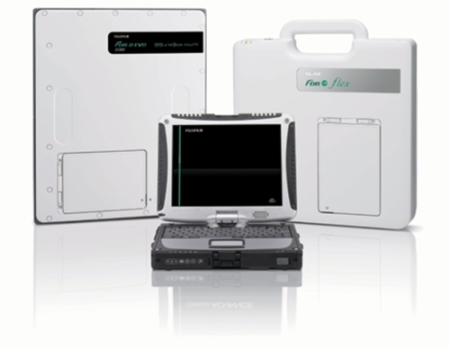Nov 26 2012
New and innovative portable digital X-ray systems from FUJIFILM Medical Systems U.S.A., Inc. take center stage at the 2012 annual meeting of the Radiological Society of North America (RSNA), with advanced technologies such as Irradiated Side Sampling (ISS) and Dynamic Visualization (DV), and many additional features that focus on improving dose and image quality performance.
 Fujifilm Exhibits Innovative Portable Digital X-Ray Systems at RSNA 2012. (PRNewsFoto/FUJIFILM Medical Systems U.S.A.)
Fujifilm Exhibits Innovative Portable Digital X-Ray Systems at RSNA 2012. (PRNewsFoto/FUJIFILM Medical Systems U.S.A.)
"Diagnostic healthcare professionals have always expected innovation from Fujifilm. At this year's RSNA we continue to meet and exceed those expectations with solutions that will clearly position us as the DR provider of choice," says Rob Fabrizio, Director of Marketing and Product Development, Digital X-ray. "Our FDR portfolio is built on our foundation of leading-edge research, with a focus on improving image quality while reducing patient dose, as well as on our tradition of consulting with the professionals who use our products day after day."
Fujifilm's FDR portfolio includes a complete line of wireless Cesium and Gadolinium flat panel detectors, our flagship FDR AcSelerate Suite and standard FDR D-EVO Suite II room replacement suites, as well as one of the most comprehensive lines of digital portables, including the latest FDR Go* and FDR-flex.
All FDR systems feature ISS, Fujifilm's patented detector technology that uniquely enhances sharpness while increasing dose efficiency. This technology is complimented with Dynamic Visualization processing which further optimizes image quality, extending visibility by dynamic recognition of density and contrast levels throughout the entire image.
Fujifilm DR brings meaningful benefits both to medical professionals and patients through lower doses, extraordinary image quality, ease of use, flexibility and much more.
FDR D-EVO
The FDR D-EVO family of wireless detectors now includes two brand new additions to the low dose, high sharpness lineup of cesium models: a large-format 17x17" and a small-format 24x30cm, traditional 14x17" design. The 24x30cm is the world's smallest wireless flat panel detector. The benefits of cesium combined with the image quality enhancements of ISS and DV take portable DR detector performance to a new level.
FDR D-EVO Suite II
The FDR D-EVO Suite II room replacement suites bring to the DR room advancements such as ISS detector technology, Dynamic Visualization, touch screen tube head controls, tube tracking, SpeedLink, increased table weight capacity and a low table-to-floor height ratio. This complete DR room replacement system is designed to optimize workflow while integrating any of Fujifilm's popular D-EVO detectors and providing workflow-enhancements such as fast image preview and cycle times and easy-to-position panels designed for patient comfort.
FDR Go* and FDR-flex
The FDR Go is an all-new Fujifilm integrated DR portable with a sleek, small chassis designed for light, easy maneuverability, the full sized power of a 32kW generator system, and an integrated FDX Console for use with any FDR D-EVO detector.
The FDR-flex is a wireless hand carry-able DR solution that instantly upgrades almost any analog portable or x-ray room to the image quality, speed and dose efficiency of DR. Just drop the mini briefcase style communication box into the portable cassette drawer, snap the laptop into its mount and you're ready to go, with endless DR possibilities.
FDR AcSelerate Suite
New this year is the release of FDR AcSelerate-flex, a new option to our fully automated positioning flagship x-ray room suite. The new "-flex" option includes a table with removable FDR D-EVO detector capability, offering expanded usability of the table's detector. This extends flexibility for uses such as for cross-table, table top and wheelchair exams, thereby providing greater ROI.
Fujifilm is also about to release two new Advanced Application capabilities for its AcSelerate line, Dual Energy Subtraction (DES) and Tomosynthesis (TS).**
Dual Energy Subtraction (DES) produces three views from two exposures: traditional, bone only and soft tissue only. These views help reveal and clarify suspect anomalies that may be obscured behind bone structures or dense tissue. Providing enhanced diagnostic detail from a routine chest exam and for follow-up on prior images help rule out the need for other exams. Fujifilm's approach to dual DES is further differentiated by three new advanced processing algorithms.
Tomosynthesis** (TS) is designed to rapidly capture up to 60 images in one fluid sweep, utilizing either the upright or the table. It can be particularly useful for exams such as head and neck trauma, shoulders, extremities and chest exams to help visualize hard-to-find fractures, or for prescreening patients to rule out the need for a traditional CT exam. This is especially beneficial to patient dose since it can be performed at considerably less dose than a CT exam.
*The FDR Go is a work in progress and is not yet available for sale in the U.S.
**Tomosynthesis requires 510k clearance and is not yet available for sale in the U.S.